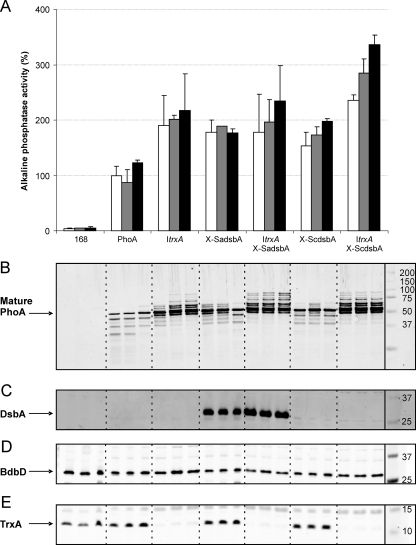FIG. 3.
Increased production of E. coli PhoA by engineered B. subtilis strains. The B. subtilis ItrxA, X-SadsbA, ItrxA X-SadsbA, X-ScdsbA, and ItrxA X-SadsbA strains and parental strain 168 (PhoA) were transformed with pPSPhoA5 for E. coli PhoA production. All mutant strains and parental strain 168 (no PhoA production) were grown overnight in LB medium containing 0.5% xylose and 25 μM IPTG (open bars) and additional 100 μg/ml cystine (gray bars) or cysteine (black bars). Next, growth medium samples were removed and used for alkaline phosphatase activity assays (A), as well as SDS-PAGE and Western blotting with specific antibodies against PhoA (B). (C to E) Lysates of cells from cultures corresponding to the samples used for panels A and B were analyzed by Western blotting with specific antibodies against S. aureus DsbA (C), BdbD (D), or TrxA (E). PhoA activity was expressed in U/ml/unit of optical density at 600 nm relative to the PhoA activity of the parental strain expressing PhoA, which was defined as 100% (6.0 U/ml/unit of optical density at 600 nm). The arrow in panel B indicates the position of mature PhoA. Bands with higher mobility on SDS-PAGE gels are breakdown products of PhoA, and bands with lower mobility are unprocessed forms of proPhoA. The arrows in panels C, D, and E indicate the positions of DsbA, BdbD, and TrxA, respectively. Note that the antibody against S. aureus DsbA is cross-reactive with S. carnosus DsbA. The positions of molecular weight markers are indicated on the right.

